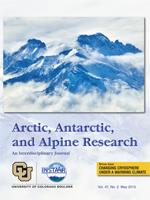Antarctic lakes are bizarre. Imagine a lake sealed by four meters of ice. Then, consider that the lake has been ice-covered for thousands of years, yet the ice is less than a decade old. Picture ice so perfectly blue and clear that light is transmitted to the briny bottom waters, 70 meters down, and warms them to a balmy 25° C—year round. Think of a water column so stably stratified by chemical gradients that the water mixes at the pace of molecular diffusion. Modern versions of Precambrian stromatolites form dense, pink, microbial pinnacles in the shallows. What about a shallow lake that blows up in a violent explosion as dense brine is pressurized as the ice freezes through the Antarctic night? These examples are only the beginning of the chemical, physical, and biological extremes described by Laybourn-Parry and Wadham in the volume, Antarctic Lakes.
Antarctic Lakes is the first book devoted to presenting the range of features of inland bodies of water on the Antarctic continent. In the Antarctic, lakes are formed at the boundaries of seas and glaciers, and in closed basins with nearly zero precipitation. Lakes may be freshwater, brackish, hypersaline, subglacial, supraglacial, or epishelf (lakes that overlie seawater). The book chapters are organized around the lake types, with a summary of subglacial lakes not available elsewhere. These subglacial lakes are among the most fascinating and include the largest (and most massive) lakes, that is, Vostok, Whillans, and Ellsworth. In recent decades, a vast network of some 380 lakes underneath the continental ice sheet have been discovered, mapped, and observed to be dynamically filling and draining.
The book includes tables summarizing lake location, surface area, depth, and salinity, which are particularly useful in providing an overview of the physico-chemical setting. Diagrams clearly illustrate lake formation and development, down to the tiny cryoconite holes that scavenge debris and meltwater, and include novel organisms. The book covers details of the Antarctic biota that exist within these unusual, and typically isolated, physical settings. The authors' expertise in microbial ecology and biogeochemistry allows a complete, interdisciplinary presentation of lake processes.
The book is well-written and illustrated. I found shortcomings to be minor. As a biologist, the sharp ammonium gradients in Plate 12 are compelling, but the point may be lost on many readers. Perhaps the occurrence and implication of these gradients could have been expressed in a schematic diagram and accompanying text. The organization of tables by “freshwater” and “saline” is somewhat artificial, as some lakes have such sharp gradients that they have dilute waters on the surface, becoming many times the salinity of seawater on the bottom. Alternatively, a single table organized by lake size might have been sufficient.
The authors state that their goal is “to produce a book that would be of general interest to those with a limited knowledge of Antarctic lakes, as well as a reference book for experienced researchers in the field,” and they have reached that objective. The features of Antarctic lakes are found nowhere else on earth, and this book allows a glimpse of these physical, chemical, and biological extremes.





